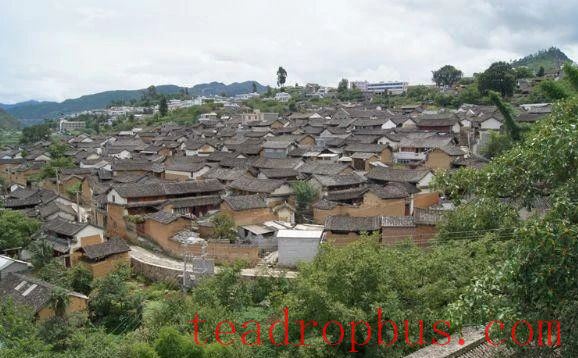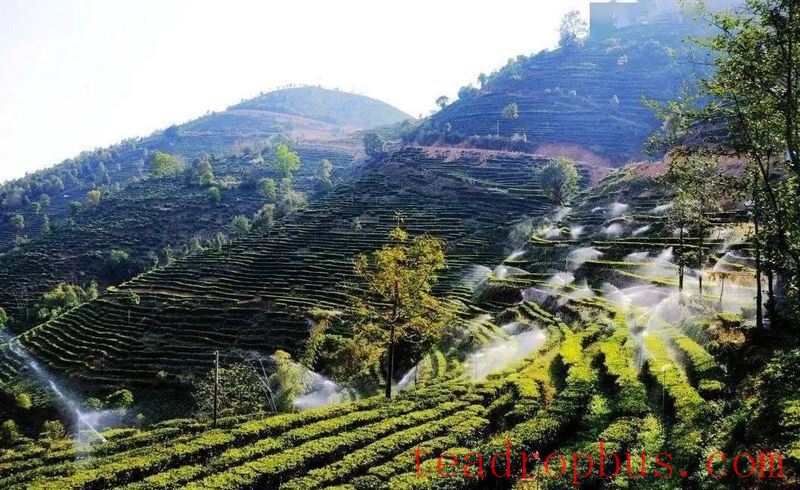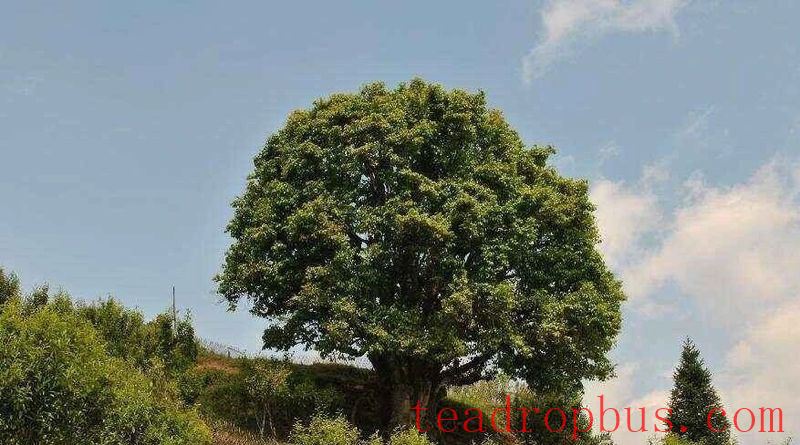When we arrived at Tuanjie Pass, it was already noon. As it was the rainy season, the less than a hundred-mile journey from the county town took our off-road vehicle over three hours to complete, as it struggled through the mud. The road was made of soil and stones, with mud mixed with gravel, making it slippery when wet; the off-road vehicle had to be driven in low-range four-wheel drive mode to pass. There were about four to five bends where we had to reverse several times.
The drizzle brought a gentle breeze that seemed to carry a faintly sweet scent. Looking out of the car window, everything was lush and verdant. The car shook quite a bit, making it impossible to take photos, and if we stopped to take pictures, other vehicles wouldn't be able to pass. So, we could only keep the beautiful scenery in our minds.

Tuanjie Pass is a place located in Lushi Town, Fengqing County, Lincang City, Yunnan Province, which has become known in recent years for nearly a hundred ancient tea trees, some of which are hundreds or even thousands of years old. In fact, this place has never been uninhabited, but it has had little contact with the outside world. At the entrance to the mountains stands a tower about one meter and twenty centimeters high, solidly built from local stone blocks. The top of the tower is flat, with a stone sculpture on it. After examining it carefully, I thought it might be a “mountain guard tiger,” but when I asked local elders, they all believed it was a bear, and that it had been there since the Ming dynasty, more than 400 years ago. In front of this “bear,” a grove of ancient tea trees stands scattered across the slope. Some of them have plaques hanging on them, while others do not. One of the larger trees is about ten meters tall. I heard that this tea tree produced 12.8 kilograms of dried tea this spring, which sold for 36,000 yuan per kilogram. I thought to myself that this must be a precious tree, capable of earning 400,000 to 500,000 yuan in just one spring.
We entered a farmer's home. The host warmly greeted us upon seeing us, inviting everyone to sit down and offering cigarettes. The host is 59 years old, and his front teeth are almost gone, and the wrinkles on his face make him look like a father figure to someone my age. After passing around the cigarettes, the host turned and picked up a plastic basket, pointing to the west side of the courtyard and saying, “The fruits are ripe. I'll go pick some fruit for you to try.” Following the direction he pointed, there were a few plum trees swaying their heads in the breeze. Someone shouted loudly from behind, “Be careful!” A short while later, he returned with a basket half-full of plums, and his right foot, wearing a plastic slipper, was bleeding from the big toe. “It's been raining these past two days, so the trees are a bit slippery,” he said with an air of nonchalance. One of our group fetched a band-aid and wrapped his injured toe. As we ate the plums he had picked, a warm feeling welled up inside us.
Leaving his house, we saw the stone sculpture again. I looked at it carefully; its head resembled a lion, and its body was like a tiger. Walking around to the back, I saw a short, straight tail and understood why the locals thought it was a bear.

We then went to another farmer's home. The young people in this family had gone out to work, leaving a 40-year-old son to care for his elderly mother. Seeing so many visitors, he, who didn't speak very clearly, became slightly stammering, “Do you want to eat…eat…sunflower seeds?” He then went into the house and brought out a small blue-and-white porcelain bowl. Everyone examined it and came to the conclusion that it was likely a piece of Ming dynasty blue-and-white porcelain, from a folk kiln. I knew little about it and continued chatting. At this moment, a friend leaned over to me and said, “Look at this old lady; she's 83 years old and doesn't have any blemishes on her face.” Indeed. The old lady sat in her special chair the whole time, smiling quietly as she watched the guests Drinking Tea and eating sunflower seeds. When we bid her farewell, she didn't say a word, merely waving her hand with a smile. My friend mentioned that this old lady had never left Tuanjie Pass in her entire life.
After leaving the old lady's house, we followed the path upwards behind the stone “bear” to a tea plantation. Along the roadside were a few larger tea trees, and I asked why they weren't being harvested. “These are wild tea trees. The surface of their leaves is very smooth, and drinking this tea can easily cause diarrhea,” explained someone knowledgeable about tea.
Looking back from the hillside, all we could see was a sea of green, dotted sparsely with homes, all covered with slate roofs and stone walls. Descending the mountain, we bumped along for about two hours before arriving at Lushi Town in the evening.
This is a major town on the ancient Tea Horse Road. In 2013, the Tea Horse Road was listed as a national key cultural relic protection unit. Standing in front of the cultural relic protection plaque, Mr. He, who was traveling with us, pointed to the Village across the way and introduced it to me, “The one on the left is called Golden Rooster Mountain, and the one on the right is called Phoenix Mountain. My hometown is on Golden Rooster Mountain.”

Walking on the stone-paved roads that the ancients trod hundreds of years ago, we occasionally saw remnants of horseshoe prints. Due to long-term trampling, some of the stone slabs had large cracks, with one or two weeds growing out of them, struggling to survive. Here, I could faintly see the bustling prosperity of the ancient town of Lushi in the past.
After lunch the next day, we headed back to Fengqing County. On the road leading to the county, a fellow traveler pointed to a village by the roadside and said, “Xu Xiake drank Taihua tea here back then.” Upon returning, I checked the book, “Records of Xu Xiake's Travels,” which reads, “I got up and had breakfast. The camels were waiting to collect the salt price, and we started off at noon… We descended another three miles and passed through a village, which was already dark. We descended another two miles and stayed at Gaojiancao. The innkeeper, surnamed Mei, was quite hospitable and specially boiled Taihua tea for me to drink.” This refers to the 14th day of the eighth month of the lunar calendar in 1639. The name “Gaojiancao” at that time is now written with a different character, “Gaojiancao.” The difference is that the innkeeper, Mr. Mei, served Taihua tea to Xu Xiake back then, while local friends served me “Tuanjie Pass” tea. Xu Xiake was traveling from north to south, while I was going from south to north. It has been nearly 400 years between us.
Fengqing used to be Shunning Prefecture, formerly known as Pumen, a transliteration of the Yi term “Puman,” referring to the ancient Pu people, ancestors of today's Bulang and other ethnic groups. Local annals record that “the Pu people were good at making tea.” It is no wonder, then, that Fengqing is famous for producing Black Tea.
If there are any copyright issues, please contact us for removal.